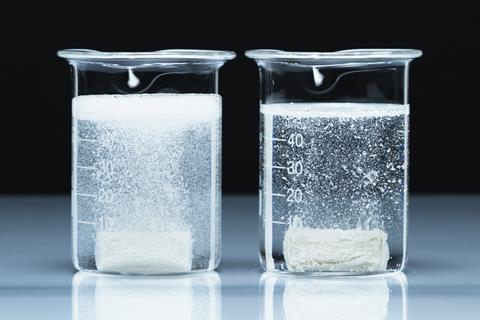Concentrate on these six teacher-tested tips and you’ll avoid diluting your students’ knowledge
Strong and weak acids is a deceptive topic. It seems simple. Yet it is at this point in the 14–16 curriculum that student understanding can collapse like a house of cards. You can rebuild that house with excellent subject knowledge and a well-planned curriculum sequence.

1. Check your pedagogical content knowledge
This topic isn’t on all the chemistry/science 14–16 syllabuses at all tiers. So you may go a few years between teaching it, meaning it is easy to forget the nuances of the language and the tricky bits of related chemistry like equilibrium. Read the topic in a good textbook before the lesson to help you approach this difficult concept with greater confidence.
2. Evaluate how your 11–14 curriculum supports progression
There are lots of resources that tell students a substance with a pH of 4 is a weak acid. As pH is a function of both concentration and extent of dissociation, this is incorrect chemistry rather than a simpler model. Evidence shows it is better to avoid language classifying substances as weak or strong in the early years of learning chemistry. Instead use comparison statements such as ‘substance A has a pH of 1 which means it is more acidic than substance B which has a pH of 4’. We have no control over what students might read on the internet in their own time, but we can control what they experience during lessons. Look through your 11–14 resources and consider adapting them if necessary.
3. Bring together related knowledge
Reinforce understanding of this new knowledge by linking it to other concepts in prior learning showing students how interrelated chemistry is. Students already know a lot of related chemistry by the time you’re teaching acids. Get them to recall the related concepts using careful questioning such as ‘what is the ion responsible for acidity?’. Targeted questioning in a class you know well can let every student have a chance at success and boost their esteem as they approach a new and challenging topic.
Use these questions to relate to other chemistry topics
- What is the ion responsible for acidity?
- Why does it have a positive charge?
- What is the ionic equation for neutralisation?
- What is the link between the pH value and the concentration of H+ ions?
- How do we calculate concentration?
4. Explicitly teach the language
Weak and strong are used in everyday language which can result in misconceptions in science. For example, a drink of squash can be described as tasting ‘strong’ when really in science terms, it is concentrated. By anticipating issues we can help our students to form the right mental models when we are giving explanations. Weak and strong should be described in terms of extent of dissociation and dilute/concentrated in terms of amount (in moles) or mass of a substance per unit volume.
5. Use diagrams and models to strengthen understanding
Dissociation in particular can be a difficult concept for students to mentally visualise so provide drawings and models to make an abstract concept more real. Diagrams don’t have to be complicated; a simple HX acid splitting into H+ and X- is effective at getting the point across. Labelling Lego bricks can help to model the breaking apart of the molecule into the ions.
For students who find the concepts and associated words difficult, visuals and models can make a huge difference. It also models good study habits. Dual coding combines written or verbal materials with visual materials which can help students recall information later on. Show students good ways of combining diagrams with words to help them make their own when they are revising.
6. Get everyone involved
This is one of the later topics in the 14–16 course and your teaching will uncover lots of gaps and misconceptions as students draw on many different ideas to make sense of it. It can be easy for some students to feel disheartened and mentally check out of lessons. Mini whiteboards are an excellent tool to check understanding and make sure the whole class is moving forward with their understanding. With students in good routines, mini whiteboards are not just a tool for the starts and ends of lessons, they can provide useful assessment for learning opportunities mid-lesson.
Ask students to draw a diagram representing a weak acid in solution, write a dissociation equation for H2SO4 and suggest the position of equilibrium or give the definition of a concentrated solution. Praise good examples and make a note of students you might need to check in with more closely.
More ideas for teaching strong and weak acids
- Tackle misconceptions about acid strength with this worksheet.
- Use the acids and alkalis toolkit from Best evidence science teaching resources.









1 Reader's comment